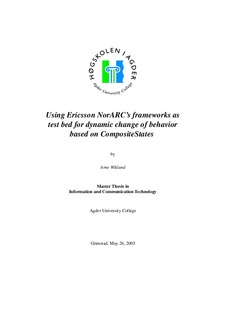| dc.description.abstract | Frameworks are a widely used re-use technique in the object-oriented community
today. A framework re-uses both code and design and makes it easier to develop
new components. Ericsson NorARC (Norwegian Applied Research Center) has
developed a set of frameworks; JavaFrame, ActorFrame and ServiceFrame to aid
advance service development. JavaFrame is a modeling kit for Java with good support
for state machines. ActorFrame is a framework emphasizing the actor and role
notion. ServiceFrame emphasize the modeling of service functionality.
UML is today’s de facto standard for visualizing, specifying, constructing and documenting
software systems. Modeling software in advance of making them is just
as essential as having a blueprint of any large building construction. Failing to
generate unambiguous models and lack of support for component-based modeling
has impelled a demand for revision of today’s UML standard.
This thesis evaluates the NorARC service creation environment, and especially
JavaFrame and ActorFrame, with a view to dynamic service behavior update. More
specified, if and how a state machine’s state space (composite state) can be altered
during run-time (i.e. dynamically changing its behavior). Further, the thesis evaluates
the possibility of showing this dynamic substitution and behavioral change in
UML 2.0.
Based on the guidelines and patterns from JavaFrame and ActorFrame, as well as
a thorough inspection of the UML 2.0 proposal, state machines and asynchronous
communications, some conceptual ideas has been developed. These range from
state machine equivalence to 1:1 UML 2.0 modeling. A prototype is made demonstrating
some of these concepts.
Through this thesis project, we have discovered that the NorARC service creation
environment is, at present state, probably not the ideal framework for run-time
behavioral update trough CompositeStates. Further, we have discovered that it is
possible to model run-time introduction of composite state, using interaction diagrams
in UML 2.0. On the other hand, no solution to modeling such dynamic
change of behavior is found, neither with UML 1.4, 1.5 nor the proposed UML 2.0
standard. | en |
